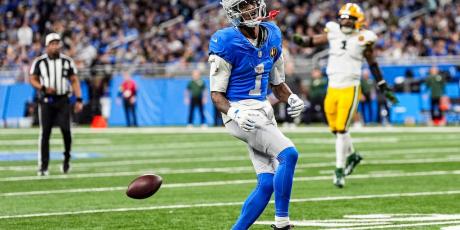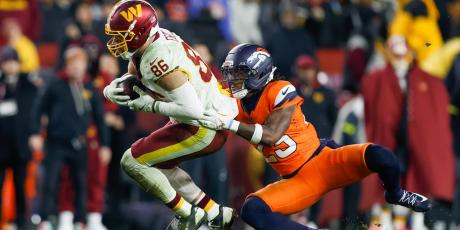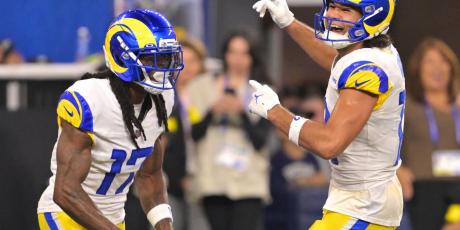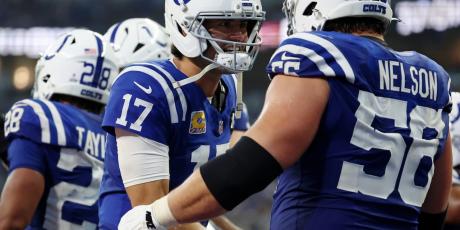Running Back Sleepers, Values & Breakouts

As regular readers know, I tend to follow the touches when attacking the running back position in fantasy drafts, and that usually means drafting 1-2 heavy-usage backs in the early rounds.
This year, there are quite a few high-touch backs available in the 3rd-7th range, the so-called “RB Dead Zone,” and some intriguing breakout candidates still on the board even later in drafts, so the “Hero RB” strategy—drafting one bell-cow back early on and then drafting a few guys to potentially fill your RB2 spot—is quite appealing. And those managers who want to ditch the position completely in the first few rounds (with a Zero-RB approach) can wait and find quality values later on.
Below is a list of Values, Breakout Candidates, Sleepers, and Potential League-Winners that might help fantasy managers sort out their running back strategies in 2023.
More Sleepers, Values & Breakouts: QB | WR | TE + Draft Day Strategery & 99 Stats to Know
Values
Here are several backs going in the 3rd-8th range who appear to be very good values due to their expected usage and production.
Aaron Jones, Packers
Aaron Jones finished as the fantasy RB9 in each of the last two seasons, yet he’s the 17th running back off the board in early drafts. His detractors will likely point to his age (28, not a major concern) and the Packers’ offense, which is expected to take a step back after the loss of Aaron Rodgers. Yet the Packers had an off year in 2022—14th in points scored, 17th in yards from scrimmage—and Jones still posted top-10 numbers at his position.
He has averaged 16.6 touches per game over the last four seasons and is typically a big part of the game plan whenever he’s available. And he’s usually available—he has just four missed games in the last four years.
To top it off, he’s really good! Last year, he was seventh in yards after contact per attempt, 15th in broken tackles per attempt, and third in PFF’s rushing grade. He has the fifth-most receptions, the sixth-most receiving yards, and the second-most receiving touchdowns among running backs in the last two seasons. I’d have no problem rolling with Jones as my RB1 if I were to wait until the late-third/early-fourth round to draft my first running back.
Miles Sanders, Panthers
Miles Sanders finished as the fantasy RB11 last season after a 12-game, RB41 finish the year before. He scored 11 rushing touchdowns in 2022 after posting a goose egg in touchdowns in 2021. (TD regression is a real thing, folks.) Now he moves on to Carolina, where he should serve as the team’s lead back, if not their bell cow.
The Panthers want to get Sanders going again as a receiver. Remember, he caught 50 passes as a rookie but didn’t eclipse 30 catches in any of the three following seasons. If he can stay healthy, 300 touches—250 or so touches with 50 catches—is within his range of outcomes.
Rushing-wise, the Carolina offensive line was a top-10 unit last year, per Football Outsiders, and as a receiver, Sanders should provide an outlet for rookie QB Bryce Young when plays break down. Sanders looks like a solid value as the RB19 off the board.
Kenneth Walker, Seahawks
As a rookie, Kenneth Walker finished as the fantasy RB19, but he didn’t earn his first start until Week 6. From that point on, he was the fantasy RB7. So why is he the 16th back off the board? Simply put, the Seahawks used a second-round pick on Zach Charbonnet, a talented back with three-down potential.
Walker only caught 27 passes as a rookie so Charbonnet could immediately see a role on third downs. (Charbonnet caught 37 passes in his final season at UCLA while Walker had 19 total receptions in three collegiate seasons.) Seattle’s offensive line was 30th in Football Outsiders’ adjusted line yards and they didn’t do a whole lot to improve the unit.
Walker’s production will depend largely on his carry share in Seattle’s backfield, but with Charbonnet in the fold, his ceiling isn’t nearly as high as it could be. Still, he’s a talented back with proven production who is likely to see 16+ touches per game and he’s available in the fourth round.
Cam Akers, Rams
Cam Akers is the 20th back off the board in early drafts, but he has major usage upside as the Rams’ primary back. Darrell Henderson is gone and Sony Michel retired, so it will be Kyren Williams, Zach Evans, and Ronnie Rivers competing for touches behind Akers.
From Week 11 on, Akers averaged 17.2 touches for 89 yards and 0.75 touchdowns per game. The resulting 13.8 fantasy points per game are more than what James Conner averaged (13.6) as last year’s RB10 in per-game scoring.
The Achilles injury is a concern for Akers, but he averaged 4.83 yards per carry after Week 11 and they started getting him involved as a receiver by the end of the season. He had nine catches in his final four games and surpassed 104 rushing yards in his last three games. If this sort of production carries over in what should be a bounce-back season for the Rams’ offense, Akers will have a great chance to beat his fifth-round ADP.
David Montgomery, Lions
Want boring value in the middle rounds? Look no further than David Montgomery in the seventh round. He’s replacing Jamaal Williams, who finished as the fantasy RB12 last season while averaging 63 yards rushing and 1.0 touchdowns per game. The Lions drafted Jahmyr Gibbs with the No. 12 overall pick, and he’ll surely see a lot of usage, but they won’t want to go overboard with the 199-pound back.
With both Williams and D'Andre Swift gone, this is shaping up to be a Gibbs/Montgomery backfield with Montgomery handling 250 or so carries and most, if not all, of the goal-line work. Given the potency of the Lions’ offense and the quality of Detroit’s offensive line, Montgomery should be able to outproduce his RB27 ADP. Williams averaged 15.9 touches in the 14 games he played with Swift—I envision similar usage for Montgomery.
Dameon Pierce, Texans
The former fourth-round pick had an excellent rookie season, turning 250 touches into 1,104 total yards and five touchdowns even though he only played 13 games. (He was on pace for 1,228 rushing yards before his injury.) Houston’s line was the second-worst in the league in adjusted line yards (per Football Outsiders), though the addition of second-round center Juice Scruggs should help.
Dameon Pierce averaged 19.2 touches per game as a rookie, but that usage is in some jeopardy after the Texans gave a healthy contract to free agent Devin Singletary. The good news is that Pierce was an advanced stats machine as a rookie, finishing fourth in yards after contact per attempt, second in broken tackles per attempt, and 12th in PFF’s rushing grade.
With C.J. Stroud at quarterback, the offense should be better able to sustain drives, stay competitive and stick with the running game. This could lead to a fantasy RB2-type season for Pierce, but it depends on what the team has in mind for Singletary. Early preseason usage indicates that the Texans aren’t planning to use Singletary as their primary third-down back, so he may be a pure handcuff to Pierce.
James Conner, Cardinals
James Conner followed up an RB7 finish in 2021 with an RB17 season in 2022, though he missed a few games due to injury. From Week 10 to Week 17, he was the fantasy RB5, averaging 21.3 touches for 102 total yards and 1.0 touchdowns per game. He just turned 28 and didn’t fare particularly well in the yards after contact or tackle-breaking advanced metrics. However, he seems to have a stranglehold on the Arizona backfield and he’s always been a solid receiver.
It’s not often that drafters can get this sort of locked-in workload in the sixth round, but given the depth of the position, that’s the case this year. The Cardinals’ offensive line was a bottom-10 unit in Football Outsiders’ Adjusted Line Yards, but the team did add center Hjalte Froholdt and guard Elijah Wilkinson in free agency, and drafted tackle Paris Johnson with the No. 6 overall pick, so this could be an improved unit. Kyler Murray’s injury status looms large, but from a workload standpoint, Conner projects to be a solid value given his RB23 ADP.
Javonte Williams, Broncos
Javonte Williams’ fantasy outlook primarily depends on his recovery from a torn ACL (and a torn LCL and PLC) in his right knee. While that sounds terrible, he was on the field as a limited participant in OTAs and was cleared for contact in training camp, which are great signs for his early-season outlook in 2023.
We know he’s good. As a rookie, he was seventh in yards after contact per attempt and led all running backs in broken tackles per attempt (per Pro Football Reference). Last year’s numbers were similarly strong in the four games that he played.
Under normal circumstances, he’d be pushing for RB1 draft status, but as it stands, he’s the 25th back off the board in early drafts. The Broncos signed Samaje Perine and it’s likely he’ll have a big role even when Williams is fully healthy. If Williams is able to play in September, I’d expect a 50/50 split between the two moving to a 60/40 or 65/35 split once Williams proves his health. He should be a valuable contributor in the back half of the season.
Alvin Kamara, Saints
Alvin Kamara pled no contest to a misdemeanor charge, which means his off-the-field trouble is resolved as far as the legal system is concerned. The NFL announced he’d be suspended for three games. Most pundits thought the suspension would last 4-6 games, so fantasy managers could have an RB2 with weekly RB1 upside available for the stretch run at the cost of a middle-round pick. He was the fantasy RB19 last season and was 13th among the 42 backs who saw 100+ carries in yards after contact per attempt. There are only a handful of backs going outside the top 100 who have his level of upside.
Breakout Candidates
Alexander Mattison, Vikings
In a minor surprise, the Vikings re-signed Alexander Mattison to a two-year contract worth $7 million. His guaranteed money ($6.35 million) was the fourth-most among this year’s free agent class behind Miles Sanders, David Montgomery, and Jamaal Williams. With Dalvin Cook out of the way, Mattison has a great chance to finish as a fantasy RB1.
In the 14 games Mattison has seen at least 10 carries, he has averaged 18.1 touches for 88 yards and 0.57 touchdowns. The resulting 13.0 half-PPR points per game are about what Jamaal Williams and Aaron Jones averaged as low-end RB1s in 2022. Even better—in his seven starts from 2020-21, he averaged 23.3 touches for 118 yards and 0.72 touchdowns per game. That production would have beaten out Saquon Barkley and Nick Chubb last season. Mattison posted the No. 14 rushing grade at PFF in 2022.
The fantasy community remains skeptical of Mattison. His RB21 ADP has him going off the board near the 5th/6th turn.
James Cook, Bills
Per GM Ken Dorsey, the Bills are “really excited” about James Cook and even said he has “three-down back” potential. Damien Harris and Latavius Murray are in the mix, but it sounds as if the Bills want Cook to be the lead back.
Among the 52 backs with at least 80 carries, Cook was 17th in yards after contact per attempt and 39th in broken tackles per attempt. He had the No. 26 rushing grade at PFF (out of 60 qualified backs) and was 15th in yards per route run at his position.
I’m definitely worried about his touchdown upside with Josh Allen and Harris potentially vulturing goal-line opportunities, but Cook could put up big yardage totals in the Bills’ high-octane offense.
Rachaad White, Buccaneers
Rachaad White “took over” as the starter in Week 10, and from that point on he was the fantasy RB29. In his defense, he was still splitting time with Leonard Fournette. White averaged 15.2 touches for 65 yards and 0.25 touchdowns while playing 49% of the snaps. Fournette was still playing around 46% of the snaps once he ceded the starting role. Per Pro Football Reference, White was 38th in yards after contact per attempt and 34th in broken tackles per attempt. He was 55th out of 62 eligible running backs in PFF’s rushing grade. So it’s not like White tore it up in a limited workload.
At this point, his fantasy value relies on his expected volume—his primary competition is 2022 disappointment Chase Edmonds and Ke'Shawn Vaughn—and the fact he caught 50 passes as a rookie. As I often say, we need to “follow the touches” when identifying value at the running back position and White should see plenty of work as the Bucs’ No. 1 RB. He looks like a solid value as the RB24 off the board in early drafts.
Khalil Herbert, Bears
David Montgomery is gone, so Khalil Herbert is the top returning rusher (129 carries for 731 yards and four touchdowns). His advanced stats are really, really good. Among backs with 100+ carries, he was second in yards after contact per attempt and 10th in broken tackles per attempt (per Stathead). In his four games last season with 13+ touches, he gained 169, 101, 87, and 99 yards from scrimmage and scored four total touchdowns.
The Bears signed D'Onta Foreman and drafted Roschon Johnson, but early in camp, the pecking order has been Herbert, Johnson, and then Foreman, so Johnson seems to be the bigger threat. (Herbert has apparently looked impressive, however.) Johnson has a great draft profile, but Herbert should be able to hold him off given his experience and production to date. As the RB34 off the board, he’s one of the last “penciled-in starters” available. If he’s able to improve his pass-blocking, he could be a three-down back.
Isiah Pacheco, Chiefs
Isiah Pacheco settled into the No. 1 RB job in Kansas City by midseason, finishing with 960 total yards and five touchdowns. He has 4.37 speed, but he didn’t fare particularly well in PFR’s advanced running back stats. He was 39th (out of 40 eligible running backs) in broken tackles per carry, which is surprisingly poor for a player who runs as hard as he does. His PFF rushing grade (74.2) was solid but not great.
Pacheco started seeing double-digit carries consistently in Week 10. From that point on, he was the fantasy RB18. And that was with Jerick McKinnon tearing it up as a receiver down the stretch. The Chiefs did get Pacheco more involved as a receiver late in the season—he averaged 1.7 catches for 19.5 yards per game from Week 12 to Week 17 and had six catches in three playoff games. If the Chiefs run a Pacheco/McKinnon committee again—and it looks like they will—then Pacheco has RB2 upside.
Sleepers
Brian Robinson, Commanders
Brian Robinson Jr. shares the backfield with Antonio Gibson, who has a couple of low-end RB1 seasons under his belt (2000, 2021). Last year, Robinson finished RB39 in 12 games—after recovering from a gunshot wound–but was the RB29 from Week 6 on, once he got settled in. From Week 9 to Week 15, with J.D. McKissic sidelined and Gibson healthy, Robinson out-touched Gibson 18.7 to 13.5, outgained him 87.3 to 58.0, and was the RB22 in that span. Robinson’s yards per carry (YPC) was slightly better than Gibson’s on the season (3.9 to 3.7), but significantly better in that Week 9 to Week 15 span (4.5 to 3.7).
Gibson’s advanced rushing metrics fell off after they were pretty solid in 2021. Robinson was nothing special—38th/52 in yards after contact per attempt and 35th/52 in broken tackles per attempt—but he was still better than Gibson (46th and 40th, respectively.) Robinson is an 18-touch back going off the board RB33 near the 8/9 turn. He’s going to share the backfield with Gibson and is unlikely to turn into a big threat in the receiving game, but getting that sort of usage in the late-middle rounds is rare.
Jerick McKinnon, Chiefs
Jerick McKinnon re-signed with the Chiefs and should remain in a 1-2 role with Isiah Pacheco. He saw his usage pick up in Week 9, and from that point on, he was the fantasy RB7 on 9.1 touches per game. At one point he had nine touchdowns in a six-game span, and that’s a run unlikely to be repeated, but he should continue to catch a lot of passes out of the backfield given the team’s lack of depth (and proven targets) at the receiver position.
Kenneth Gainwell, Eagles
The Eagles are very likely to utilize a backfield committee this season after Miles Sanders (279 touches) left via free agency. However, as the third Eagles back off the board, Kenneth Gainwell may be poised to serve as the lead back. His snaps increased as last season went on, and he saw 37%, 42%, and 51% of the snaps in the Eagles’ three playoff games, out-snapping (51% to 35%) and out-touching Sanders (11 to 7) in the Super Bowl. Gainwell (and Boston Scott) got the night off in the first preseason game, and HC Nick Sirianni said after the game that the starters didn’t play due to joint practices the following Monday. Hmm.
Four beat writers—Shamus Clancy, Jeff Kerr, Andrew DiCecco, and Eliot Shorr-Parks—believe Gainwell has had the best camp, has seen the most touches, and is poised for lead-back duties in 2023. D'Andre Swift and Rashaad Penny are both talented, and will likely be involved, but there’s a chance Gainwell is the No. 1 RB in this group. With an ADP of RB52 in the 13th round, managers should get some exposure.
Samaje Perine, Broncos
After a few seasons serving as Joe Mixon’s backup, Samaje Perine decided to move to Denver where he should have a big role alongside Javonte Williams, who is recovering from a late-season ACL tear. Perine has a career 4.0 yards per carry, but he’s a good receiver—101 catches on 122 career targets—so he’ll have a chance at RB2/RB3 numbers in PPR formats if he’s given a sizable workload. New HC Sean Payton does have a history of divvying up the backfield duties (a la Alvin Kamara and Mark Ingram).
Jeff Wilson, Dolphins
Now that Dalvin Cook has found a team, it’s time to give the Dolphins’ backs another look, and Jeff Wilson looks like a better bet than Raheem Mostert. Wilson out-touched Mostert in every non-injury game after joining the Dolphins last season. In those six non-injury games, Wilson averaged 15.2 touches for 76.2 yards and 0.67 touchdowns per game, which are RB2-type numbers. Mostert is still in the mix and the Dolphins added Devon Achane in the draft, but Wilson figures to get the first crack to be the early-down back in 2023.
Jamaal Williams, Saints
Jamaal Williams finished as the fantasy RB12 last season after leading the league in rushing touchdowns (17). The Lions signed David Montgomery, so Williams moved on to New Orleans, where he should play a significant role whether or not Alvin Kamara is available. The Saints’ offensive line was No. 12 in Football Outsiders’ Adjusted Line Yards, so they are a good unit, just not as good as the Lions’ offensive line.
Zamir White, Raiders
Zamir White has been the No. 1 RB in camp as Josh Jacobs continues to sit out. It’s not clear what Jacobs’ endgame will be, but he doesn’t hold much leverage. He’ll likely report for work eventually, but if he were to sit out any games, White would likely post RB2/RB3-type numbers in his absence.
Jaylen Warren, Steelers
Early preseason snap shares indicate Jaylen Warren may have a bigger role than last season. This could turn into more of an RB1a/RB1b situation this year.
Roschon Johnson, Bears
If Khalil Herbert can’t prove he can pass protect, Roschon Johnson could quickly eat into his snaps. He has a great rushing profile as well. I do think Herbert holds onto the No. 1 RB job, however.
















